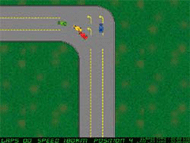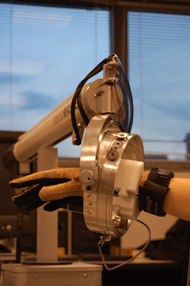Virtual Games with Haptics to Assist in Physical Therapy Involving Wrist Pronation and Supination Movements
Diego A Ramirez
New Jersey Institute of Technology – Biomedical Department
Newark, NJ 07102
ABSTRACT
Enhancement in neural response is one of the main goals for physical rehabilitation therapy. This is achieved mainly by movement repetition which facilitates the rewiring of the brain circuitry where healthy neurons may cast damaged ones. This work seeks to stimulate the active participation of the subject by adding Assistive Technology in the form of interactive games with proprioceptive feedback. A car race video game with application of wrist pronation and supination movements is given as an example of this type of assisted therapies.
KEYWORDS
Assistive technology, rehabilitation, pronation, supination, haptics, proprioception
PURPOSE
Repetitive constrained therapies have shown to be effective as a method to achieve a progressive enhancement in the sensory-motor skills in persons with neuromuscular disabilities. This is based on the theory that repetitive tasks may reorganize neural distribution and thus remap pathways in the brain. Intact neurons will eventually take over the tasks initially intended for the damaged neurons [1],[2]. Virtual reality is being used as visual Assistive Technology in an effort to achieve active and voluntary participation of an individual to result in enhancement of neural learning and increased reorganization [3],[4].
The RERC on Technology for Children with Orthopedic Disabilities at New Jersey Institute of Technology, working together with the Children’s Specialized Hospital, Mountainside, NJ, is developing interactive games which accomplish the goals of a physical therapy regimen. These games are controlled by a robot that features haptic feedback which adds proprioception as part of the virtual environment. This work presents the adaptation of an interactive car race video game where the car’s movements are controlled through pronation and supination of the wrist, all assisted by the robot with haptic properties. Effective stimuli and active participation of children with upper limb impairments creates a friendly, adjustable and slightly competitive environment.
Further studies and research will show the effectiveness of this type of therapy and will allow to measure and quantify the actual progress of the children playing the game in a controlled environment.
CURRENT TECHNOLOGY
The car race video game was initially obtained through open source code (The Code Project™ http://www.codeproject.com). The program was designed to control the car using keyboard commands. The user is competing against three more cars and the design of the game allows for choosing among different difficulty levels, each level representing a different speed on the competing cars. Modifications of the code were made to adjust maximum speeds of both the user’s car and competing cars. Several tracks are also available. As an extra feature, there the ability to edit track shapes.
A robot designed to feature haptic feedback is used to replace the computer’s keyboard as the controller of the user’s car. The robot is connected to a computer and operates through a set of servomotors that are controlled using a group of libraries in C++. The output obtained allows for the design of different haptic properties (i.e., creation of objects, resistance to surfaces, springs, damping, etc.) in three dimensional space. A ring installed in the end-effector adds the possibility of rotation, which brings three more degrees-of-freedom; although, just rotation about x-axis can be controlled by the robot.
DESIGN AND DEVELOPMENT
The source code was modified to accept inputs from the robot to command the cars in the game. The commands remain generally the same, the only change being the parameter that triggers the action and its value. For example, to rotate the car the ring has to be rotated a preset angle from the initial position. To rotate in the opposite direction the user must come back to the initial position and start rotating in the other direction. A virtual spring was installed in the ring which helps the user to return to the initial position. A slight force either forwards or backwards moves the car ahead or stops it, respectively. All these parameters (i.e., angles, spring and forces) can be modified and adjusted to adapt for different users. The end-effector of the robot is enclosed in a virtual block, allowing the user to focus on the pronation and supination movements and the slight force for car displacement.
The different level and parameter adjustments allow for the adaptation to the requirements of the user according to his/her different skill level. In addition, the robot’s variables (angles, forces and positions) can be recorded at a rate predefined in the program. This is necessary for future studies of progress and effectiveness of the therapy.
PERFORMANCE
Although the commands from the robot are made to be as intuitive as possible, the user requires some previous training to get familiar with the operation. It is important that the user understands that there is a learning curve associated with the car racing video game. For the same reason, it is important for the developer to combine properly the different parameters (e.g., speed, type of track, level of difficulty, etc) to minimize user frustration.
Finally, some additional adaptations have been made to make the game more interactive and functional. The game has a sound feature to make it more stimulating. The initial position is set displaced from the vertical axis to make it more natural for the position of the hand (currently it is designed for the right hand, if the child has to use the left hand the initial position and conditions have to be changed accordingly.) The track changes different difficulty levels according to its shape and width. This is useful for the therapy and will make game more attractive as the child becomes more proficient.
NEXT STEPS
Two Children’s Specialized Hospital patients are using this game under the supervision of developers and the physical therapists. The outcomes of this feasibility study will help to adapt the game to needs of children who will be potential users in the study. Apart from technical variables, additional outcomes to be evaluated include ergonomics, duration and difficulty level.
REFERENCES
- Chen R, Cohen LG, Hallet M (2002) Nervous system reorganization following injury. Neuroscience 111(4):761-73
- Jenkins W, Merzenich M (1987) Reorganization of neocortical representation after brain injury: a neurophysiological model of the bases of recovery from stroke. In: Sneil F, Herbert E, Carlson B (eds) Progress in Brain. Elsevier, New York
- Krebs HI, Hogan N, Aise ML, Volpe BT (1998) Robot-aided neurorehabilitation. IEEE Trans Rehabil Eng 6(1):75-87
- Foulds RA, Saxe DM, Joyce III AW, Adamovich, S (2007) Sensory-motor enhancement in a virtual therapeutic environment. Virtual reality. Online First article. DOI 10.1007/s10055-007-0067-5
ACKNOWLEDGMENTS
This study was funded by This Rehabilitation Engineering Research Center, Grant H133E030011-06, is funded by the National Institute on Disabilities and Rehabilitative Research.
Author Contact Information:
Diego Ramirez, MS, New Jersey Institute of Technology, 323 Dr MLK Jr Blvd, Newark, NJ 07102, Office Phone (973) 596-3043 EMAIL: dar9@njit.edu

